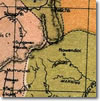
Biographical entry
| Home | Browse | Search | Previous | Next |

|
Unlocking Regional Memory
Biographical entry
|
|
Hungerford, Thomas (1823 - 1904) |
|||
|
|||
| Born: 6 September 1823 County Cork, Ireland. Died: 4 May 1904 Ashfield, New South Wales, Australia. |
|
Thomas was the sixth son of Emanuel and Catherine. The Hungerfords were members of a former illustrious family whose power in England was at its peak in the Middle Ages. The entire family emigrated from the family seat in County Cork, Ireland in 1828 with servants and schoolmaster, and arrived in Australia on 19 May1828 aboard the Alexander Henry. Thomas was privately educated with his brother, Septimus, going on to manage many of his father's properties, especially Baerami and Thungalier. In 1849 he introduced the swinging gate for drafting cattle and in 1852 married Emma Hollingsworth Wood. Emma bore eleven children before her death on 12 April 1872. By 1858 Thomas had 250,000 acres in Queensland where he ran cattle. The town of Hungerford on the NSW border was named after him. In 1860, at Baerami, he introduced systematic ringbarking into Australia and by 1870 it was being practised throughout the Hunter. He was president of the Baerami School of Arts for many years and held many other public offices. He erected a flour mill at Denman and worked for the erection of a bridge across the Goulburn River at Sandy Hollow, which bridge was named after him. In the August following his wife's death, he married Catherine Mallon and they had six children over fourteen years. In 1877 Thomas won the seat of Northumberland in the Legislative Assembly and in 1881 took up 3,000,000 acres in the Gulf Country of Queensland. He took a great interest in Aborigines and compiled an Aboriginal dictionary for his personal use. The depression of the 1890s forced his bankruptcy and his estates were taken over by the Bank of NSW. He retired to 'Kilowen', Ashfield where he lived out the remainder of his days. [Brief Biography compiled by Robin Hammond, January/February 2004] | ||
| ||
ParentSiblingRelated Families | ||
| Top of Page | ||
| ||
| ||
|
|
| ||
|
Published by The Australian Science and Technology Heritage Centre, 5 April 2004 Prepared by: Acknowledgements Updated: 23 February 2010 http://www.nswera.net.au/biogs/UNE0679b.htm |